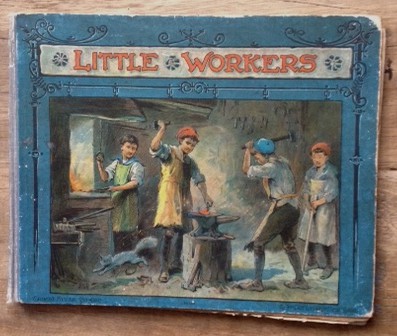Inspiring Young Readers
 posted on 18 Sep 2017
posted on 18 Sep 2017
A home for waifs and strays (old children’s books are welcome here)
Those of you with an interest in older children’s books will have come across the biggest problem of collecting in this field – the majority of these books have been owned by children. So not only does a book have to put up with the natural ravages of time, avoid the damp, hungry insects and being stashed away in attics that swing from freezing cold to boiling hot, they also have the whims and fancies of children to deal with. Pages get torn, pulled out, scribbled on and, judging by the state of some of them, partially eaten. They get skimmed across rooms, used as place mats – and they even get read. Sometimes read a lot. Actually, it’s a wonder they survive at all – especially some of the older ones.
Collectors can be a funny bunch of people and I suspect that most book dealers will tell you that they are very particular about the books they want – for the most part they are expected to be in the very best condition possible and preferably untouched and unread. Copies like that are, of course, thin on the ground and attract a sizable price premium – only to be stashed away on the shelves of adults who will only ever look at them once in a blue moon.
By contrast, we’re happy to give interesting old, beaten-up and distressed children’s books a home – as long as they’re still all there, haven’t been down the toilet or used as a throw for the pet dog. The fact that we’re much less fussy about condition means we can afford to buy great old books that collectors pass up and that we almost certainly couldn’t afford in pristine condition. On top of that we get a book that’s lived, that’s got character and which has been handed around and (hopefully) well read.
We picked up a good example of this not long ago on a trip to Leominster. Little Workers is undated but it’s probably late Victorian or early Edwardian and is a book of pictures and verses showing the presumably middle class child reader just how wonderfully happy and content working class child labourers are in their jobs. Nothing here about 20 hour days, death in chimneys or lost limbs in industrial accidents but a parade of contented mini-artisans happily going about their business. The book is pretty much completely wrecked but it’s all there and I’ve never seen a copy before – to me it’s an invaluable social document and one I’ll use with students in the future.

The first edition of the first French language Babar the Elephant we found not long ago has also had a life. Bashed and battered with a split spine it may be but the tonal quality of the illustrations in this first edition knock spots off the later reprints. For me this was £5 well spent even if some people might see it as junk.
So, I would urge everyone to try and save some of these unusual children’s books from an ignoble destiny in landfill or a waste incinerator. Even if they look a bit tatty or they have pages that spring out when you open them, don’t bin them because they offer us a window on our past and on childhood as it was lived. Let’s make sure that the readers of the future have access to these books as they are – faults and all.
Terry Potter
September 2017



